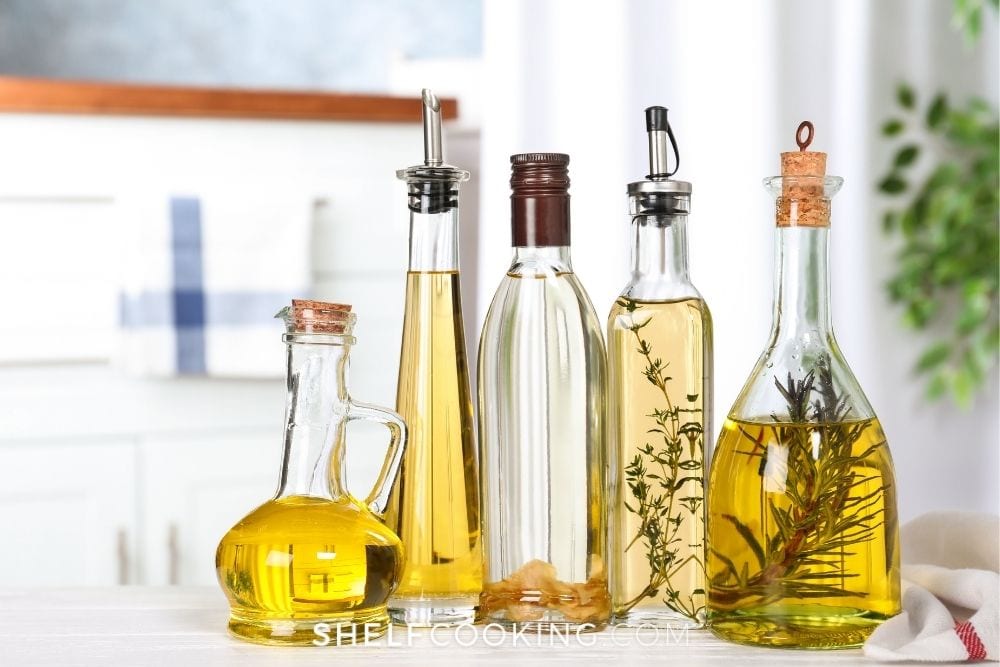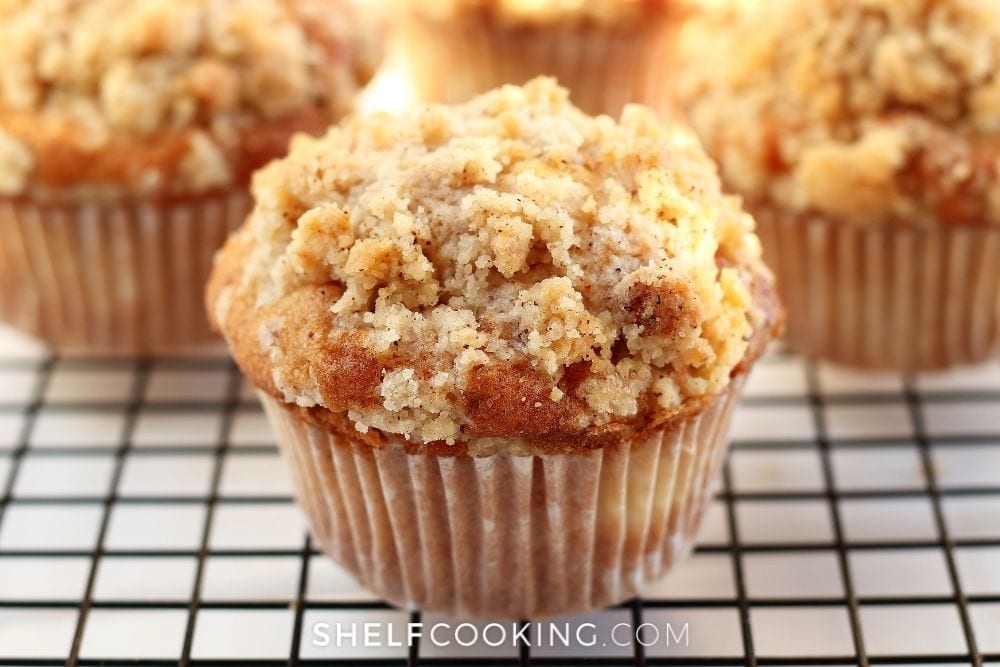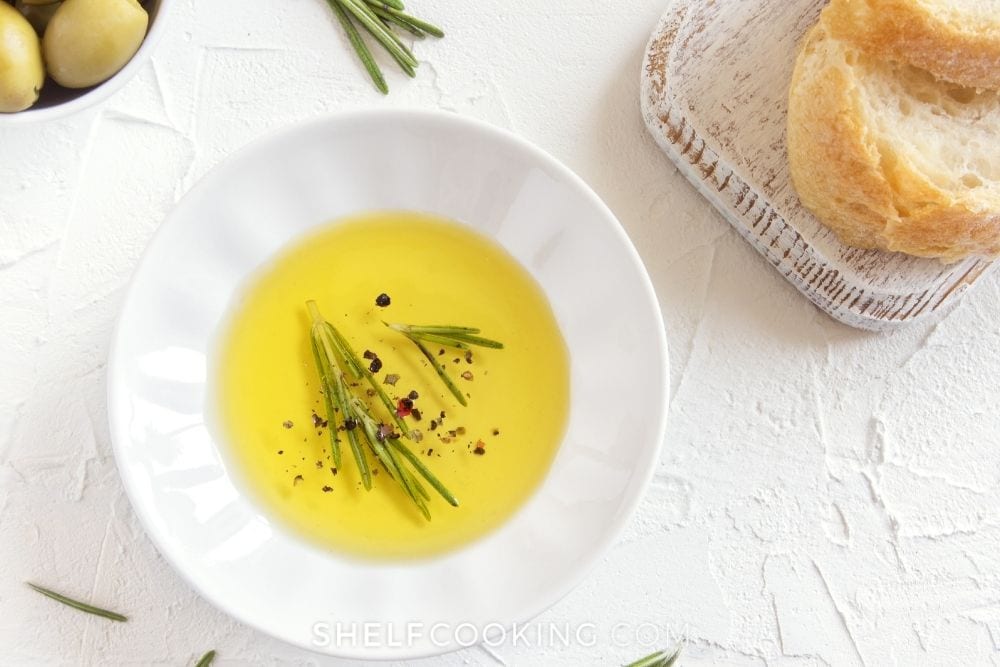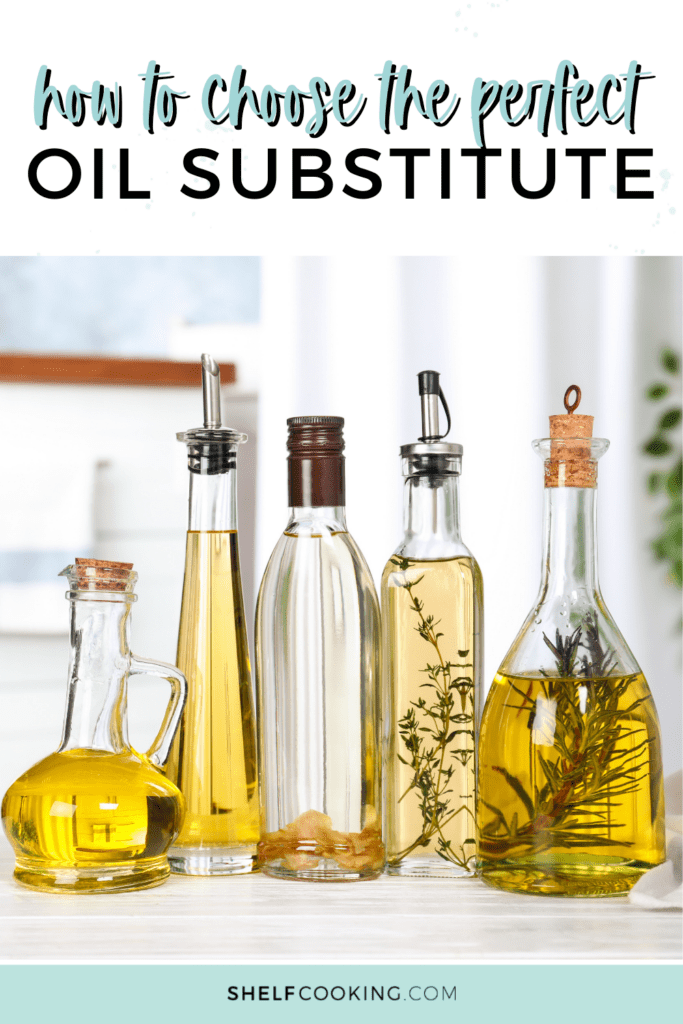Never get tripped up by oil substitutions in a recipe again! Whether you're baking or cooking, we have a list to tell you the BEST oil substitute for exactly what you're making!

Craving brownies only to find out you're fresh out of the vegetable oil the box calls for? Are you halfway through a recipe that calls for olive oil but can't find any in the cupboard? Don't fret, friend—there is a way!
*Note: When you click the links in this post, we may receive a commission at no extra cost to you.
This list will show you all the oil substitution options you need to know for both baking and cooking! Whether it's brownies, spaghetti sauce, or homemade salad dressing, we've got you covered. Trust us, you'll be an oil-swapping pro in no time!
HOW TO CHOOSE AN OIL SUBSTITUTE
While technically any oil will do in a pinch, some oils add stronger flavor to their dishes or baked goods. Some oils are mild, while others are stronger and tend to overpower their dishes or baked goods.
Not sure which one to use when? No worries, that's what you have us for. 😉 Follow our simple guide below to know which oils you can swap out when!
NEUTRAL-FLAVORED OIL SUBSTITUTE FOR BAKING

These oils are mild in flavor and typically used in baked goods. If your recipe calls for any of these oils, or a “neutral” oil, feel free to switch them with another oil in this list without tasting a bit of difference!
- Vegetable Oil – A very commonly used oil when baking or frying, vegetable oil is almost flavorless. It's also readily available at any grocery store and it's super cheap!
- Canola Oil – The second most commonly used oil, canola oil is abundant and cheap as well!
- Grapeseed Oil – This neutral oil is a bit pricier, but it's also a bit healthier as it's full of omega-6s.
- Sunflower Oil – While sunflower oil has a slightly stronger flavor profile than the previously mentioned three, it is still light and won't affect the flavor of your baked good or dish!
- Safflower Oil – Safflower oil is very similar to sunflower oil and has a light flavor and aroma.
- “Light” Olive Oil (not extra virgin olive oil) – Light refined olive oil is the only neutral-flavored olive oil. Make sure you don't grab that bottle of EVOO on accident, mama!
Any of these neutral-flavored oils work well when baking or when cooking or sautéing something that you don't want to be overpowered by the oil. Try one in our deliciously easy peach muffin recipe!
HIGH-HEAT OIL SUBSTITUTE
These oils are considered “high-heat” oils that have a high smoke point. This means they are great for sautéing or frying when those temps really get cranked up! Some are neutral in flavor and won't add to your dish while others are a bit stronger. (Which is totally not a bad thing!)
- Peanut Oil – This oil has a light flavor, but it does have flavor! It works really well for frying as it has a high smoke point!
- Vegetable Oil
- Avocado Oil – Another healthier, but pricier, oil that works great for high-heat applications like frying or sautéing. It does have a bit of an avocado flavor but it won't totally overpower a dish.
- Safflower Oil
- Coconut Oil – A high-heat oil that has a sweeter, smoother flavor. It's a great swap for butter in a recipe, too!
- Extra Virgin Olive Oil – A favorite, extra virgin olive oil (EVOO) is a great go-to because it's affordable and it adds a great mild flavor to your high-heat dishes! Use it for sautéing or pan-frying.
- Sunflower Oil
- Sesame Oil – This oil has a stronger, nutty flavor that may impact your dish! It is good for high heat applications if that's a flavor you enjoy.
If you're sautéing or frying something and the recipe calls for an oil you don't have, swap it out for one of the oil substitute options and don't think about it another second. We won't steer you wrong, we promise!
Pro Tip: If your pan with oil begins to smoke, reduce the heat until the smoke stops!
STRONGER OILS THAT ADD FLAVOR

These stronger flavored oils are not typically used for cooking or baking, but instead for finishing a dish with a drizzle, using as a bread dip, or to flavor a salad dressing. Try one in our delicious homemade vinaigrette recipe!
- Walnut Oil – This oil has a slightly sweet, nutty taste that some people love with pasta, vegetables, and even aged cheeses.
- Toasted Sesame Oil – Very different from sesame oil, so don't confuse the two!
- Extra Virgin Olive Oil – This oil doesn't have the most overpowering flavor profile, but a high-quality olive oil can add tons of flavor to a salad dressing or a bread dip. You can even find them infused with additional flavors to really make things fun!
- Hazelnut Oil – Hazelnut oil has a nutty flavor that well… tastes like hazelnut!
With the exception of EVOO, a little of these oils goes a long way, so use sparingly! You definitely do not want to use these oils in a recipe unless it specifically calls for it or you are just adding a tiny bit for taste.
WHAT ELSE YOU CAN USE IN THE PLACE OF OIL FOR BAKING
Looking for an oil substitute that isn't another oil? Here are some of the best oil subs to use when baking!
- Applesauce
- Ripe, mashed banana
- Melted butter
- Ghee
- Vegetable shortening
- Mayo
Use these oil substitutes in a 1:1 ratio! Make sure you check out our post with 30+ substitutions for even more ways to sub. Learn these and you'll be absolutely unstoppable in the kitchen—a shelf cooking pro!
WHAT OIL SUBSTITUTES ARE YOUR FAVORITE?
Whatever oil substitute you try, if you stick to these lists, your dish or baked good will turn out amazing! What is your favorite go-to oil to cook or bake with? Tell us in the comments below!

Want more great recipes and kitchen hacks?
- These 40 food hacks will seriously change your life!
- Stuck in a dinnertime rut? These yummy pork recipes will liven up a meal fast!
- Learn how to build your own kitchen herb garden and never buy fresh herbs at the store again!
Swap away, friends!
